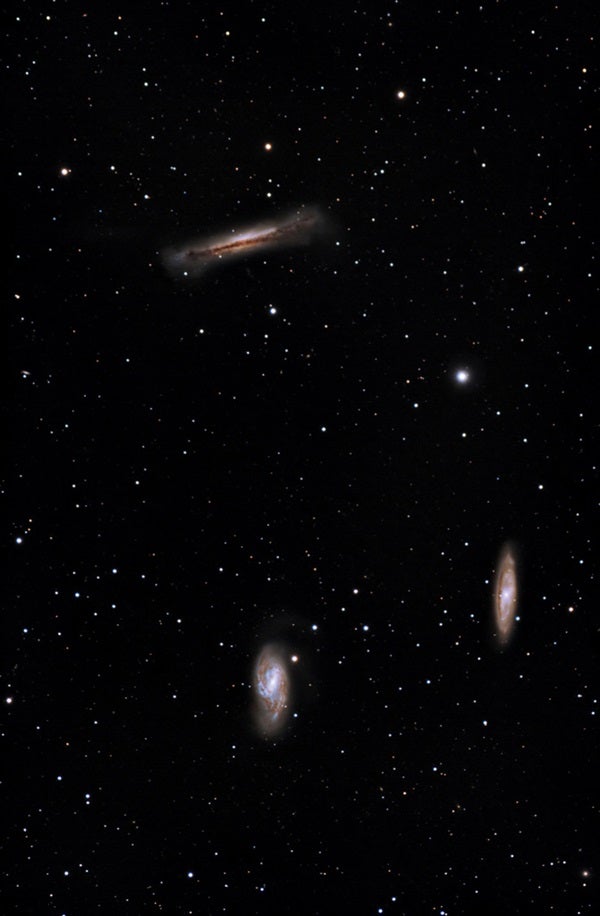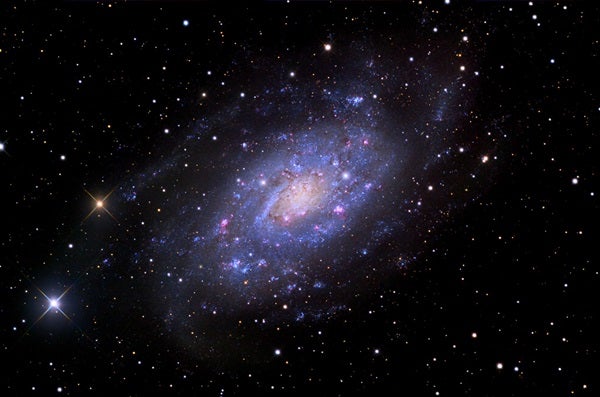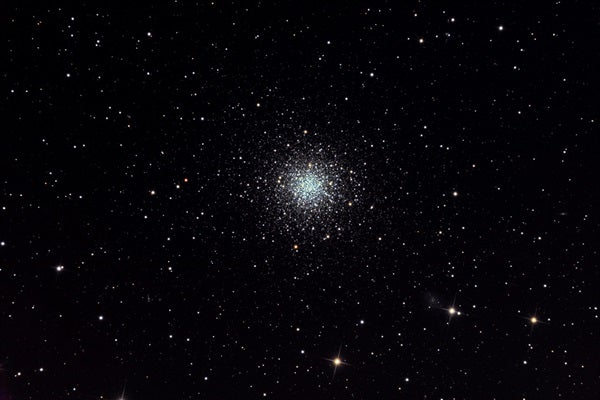Our first stop will be at three spiral galaxies that many observers know as the Leo Trio. M65 and M66 lie southeast of the star Chertan (Theta [θ] Leonis), which marks the right angle intersection in the triangle of stars forming Leo’s back and tail. Joining the pair is NGC 3628 just to the north.
I can routinely see M66 through my 10×50 binoculars from my suburban home, but M65 glows about half a magnitude fainter and requires a night with better-than-average transparency. NGC 3628 is even more challenging. You’ll need at least 15×70 binoculars to spot this one. It also helps to brace the binoculars.
Next, head one constellation west to Cancer. Splitting most double stars requires a telescope, but you can split Iota (ι) Cancri with steadily held 10x binoculars — barely. Iota is the northernmost star in the inverted Y figure that forms the central shape of the Crab. The system’s two stars have a separation of 31″, just within reach of 10x binoculars. But the fun of it is the challenge. Give it a try tonight.
I’ve spotted NGC 2403 through 10×50 binoculars from my backyard as an oval glow nestled near a triangle of faint stars. Yes, this one is also a challenge, but now is the best time of year to press your luck.
Staying in the northern sky, let’s survey a few targets in Canes Venatici the Hunting Dogs. First, scan for an eye-catching asterism of four stars that looks like a backward number 7 lying about a binocular field northeast of Cor Caroli (Alpha [α] Canum Venaticorum). Although the stars are not physically related to one another, they make a handy pointer that will lead you to the Sunflower Galaxy (M63). This spiral system will look like a tiny cigar-shaped blur, perhaps slightly brighter than M66. Can you catch it through your binoculars?
This constellation also holds a target for double-star fans. The stars 15 and 17 Canum Venaticorum shine at 6th magnitude, creating a pair of identical celestial headlights pointing our way. It turns out, however, that 17 CVn, the easternmost of the two, lies just over 200 light-years from Earth. But you would need to continue another 900 light-years through interstellar space before arriving at 15 CVn. So, while not a true binary system, the stars do form a pretty pair for springtime viewing.
Our last stop in Canes Venatici is Upgren 1, a seemingly rogue open star cluster you’ll find 5° southwest of Cor Caroli. Discovered in 1963 by astronomer Arthur Upgren from Wesleyan University, Upgren 1 looks like a tiny triangle of faint stars through binoculars. Originally believed to be the remnant of an ancient cluster that subsequently scattered, astronomers now know that the stars are just a chance asterism. Cluster or not, Upgren 1 is still a fun sight through binoculars.
Next, head straight south to Coma Berenices, a constellation famous for its profusion of galaxies. But one stands out from the rest. The Blackeye Galaxy (M64) shines at 8th magnitude, so it’s just in the range of 50mm binoculars. If, however, you are viewing through 80mm or larger binoculars, you might be able to catch its “black eye,” a dark lane of dust silhouetted in front of this spiral galaxy’s disk.
And when you do, consider that when the light you’re seeing from the cluster’s 100,000 or so stars left there 33,000 years ago, early skywatchers near Blanchard, France, were engraving lines on animal bones to keep track of the Moon’s phases.
Our final target this season can be easy, difficult, or impossible depending on where you are. That’s because the bizarre galaxy Centaurus A (NGC 5128) floats 43° south of the celestial equator. Your best chance of spotting it is when it stands due south and is therefore highest in the sky. But how will you know when that is?
Luckily, the bright star Spica (Alpha Virginis) has nearly the same right ascension as the galaxy, so we can use it as a guide. When Spica sits on the meridian (due south), so does NGC 5128. From where I live on Long Island, I can just make it out through my 10×50 binoculars; my 16x70s improve the view immensely. Centaurus A is a powerful radio source that resulted from the merger of a huge elliptical and a smaller spiral galaxy.
Many more springtime binocular targets await us on the next clear evening. Head outside and enjoy all that the season has to offer. You’ll soon know why I always say that when it comes to stargazing, two eyes are better than one.












